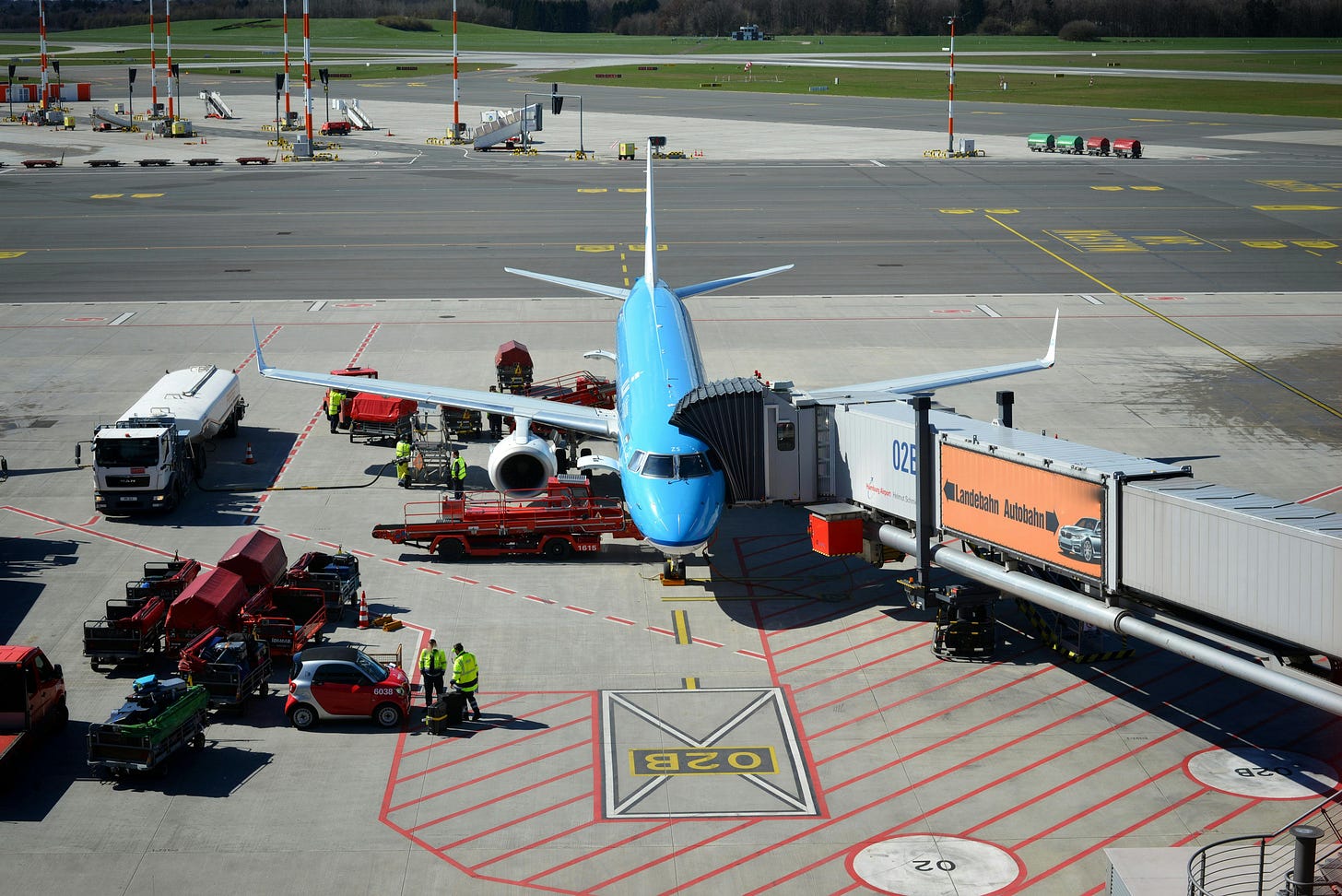How Vema's "orange hydrogen" could transform aviation fuels
Vema’s Stimulated Geologic Hydrogen process skips electrolysis, cuts costs, and could be the missing link for affordable SAF.
Can clean hydrogen be created underground – cheaply, cleanly, and without electrolysis?
A startup called Vema Hydrogen thinks so. The company just raised $13 million to prove it can produce hydrogen using a process called Stimulated Geologic Hydrogen – or ‘orange hydrogen’.
Unlike conventional methods, it requires no exploration, no massive solar farms, and uses a fraction of the energy needed for green hydrogen. If it works, it could undercut even fossil-based grey hydrogen and transform the economics of e-fuels and SAF.
Vema’s “orange hydrogen” is one of several new approaches gaining traction just as green hydrogen – once hailed as a decarbonisation Swiss army knife – is facing harsh economic realities across sectors from steel to aviation.
When the green hydrogen dream meets the cost curve
For years, policymakers and industry leaders poured money into green hydrogen, produced via electrolysis using renewable energy, positioning it as a cornerstone of the net-zero transition. A 2023 Deloitte report projected a $1.4 trillion market by 2050. But the bubble may be starting to burst.
Green hydrogen remains at least five times more expensive than fossil-based grey hydrogen. It also demands enormous amounts of clean electricity – often more than 50 kWh per kilogram.
As Mitch Gainer notes in his Green Fundamentals newsletter, while battery costs have dropped nearly 50% since 2021, the costs of electrolysers, which you need to split water into hydrogen and oxygen with renewable energy, rose by the same amount.
In fact, Gainer’s analysis of the IEA’s latest hydrogen outlook shows that just 25–30% of announced global hydrogen projects are expected to reach Final Investment Decision (FID) by 2030. Projects are stalling. Even Nel, one of the most established electrolyser firms, has paused its U.S. gigafactory and cut its workforce.
Then there are the cautionary tales. Corre Energy, a Dutch clean-tech firm listed in Ireland that aimed to pair renewable storage with green hydrogen, saw its market cap collapse from €240 million to just €7 million in two years. According to The Journal, it came down to time and money: capital-intensive projects with multi-year lead times and too few investors willing to wait.
Consequently, attention is turning to alternative hydrogen production methods such as:
'Pink hydrogen' made using nuclear energy, a favourite of Emirates President Sir Tim Clark.
'White hydrogen', the naturally occurring kind found underground. We recently spoke with Viacheslav Zgonnik, a researcher and entrepreneur who’s been tracing geological hydrogen back to Soviet-era drilling reports and sees enormous potential in it. But while white hydrogen may show promise, it still carries significant exploration risk. You have to find the gas, verify purity, and extract it economically.
Vema’s underground hydrogen factory
That’s what makes Vema’s approach compelling.
Rather than hunting for underground hydrogen, Vema is creating it – on demand, close to where it's needed, and without the geological uncertainty. The process accelerates the same natural reaction that produces white hydrogen: iron-rich rock interacting with water to release hydrogen gas. But instead of waiting millennia, Vema uses targeted injections and inexpensive catalysts to produce hydrogen in real-time.
“We’re not looking for hydrogen – we’re producing it,” explains Vema’s CSO and Co-Founder, Florian Osselin. “The earth is doing all the work. We’re just helping it along.”
Vema’s approach sidesteps many of the hurdles that have held green hydrogen back.
It doesn’t need massive amounts of clean electricity.
It doesn’t depend on government subsidies to be cost-competitive.
It doesn’t rely on rare underground hydrogen deposits.
And it doesn’t need to transport hydrogen across continents – Osselin says Vema is looking to extract hydrogen close to demand centres, wherever the right rock is found.
That last point is crucial. While white hydrogen has attracted big-name investors like Bill Gates’s Breakthrough Energy, it’s also been compared to gold exploration. You might strike it rich, but then again, you might also find nothing. In contrast, Vema creates hydrogen using the same natural reaction but in a controlled way.
“Looking for the right rock is substantially easier than looking for an accumulation of hydrogen,” argues Osselin. He uses this analogy to explain what his company is doing. If white hydrogen is gold mining, Vema is doing alchemy. Their system turns ordinary geology into a hydrogen-producing reactor.
Because the process taps into chemical energy already stored in the rock, it uses a fraction of the energy required by electrolysis-based hydrogen, making it far cheaper and much easier to scale.
In our conversation, Osselin stressed that Vema isn’t just replacing one environmental problem with another. While green hydrogen often requires large volumes of freshwater – something in short supply in many regions – Vema’s process was designed with resource efficiency and minimal impact in mind.
It uses non-potable water: seawater, brine, and even wastewater can do the job.
It involves no fracking, avoiding one of the biggest criticisms of geothermal energy.
Its catalysts are cheap, stable, and environmentally benign.
And it has a tiny physical footprint, requiring 10 to 1,000 times less land than solar or wind to produce equivalent energy.
“I'm in this business because I'm super interested scientifically,” says Osselin, “but also because I want to make an impact for the energy transition and global warming. I don't think there's a point in producing hydrogen if it's to mess up the whole subsurface in the process.”
Why aviation should pay attention
The cost of sustainable aviation fuel (SAF) remains a stubborn barrier for the aviation industry. While e-fuels show promise, offering up to 90% CO₂ reduction in a closed carbon loop, the economics are brutal.
According to EASA’s 2025 briefing note, synthetic aviation fuels can cost eight times more than conventional Jet A fuel, with hydrogen being the single biggest cost driver.
That’s why a breakthrough in hydrogen production doesn’t just matter – it’s potentially transformative.
If Vema can deliver hydrogen at under $1/kg, without subsidies, exploration risks, or huge electricity demands, it could dramatically reshape the economics of e-fuels. Think green methanol, produced at industrial sites near airports or SAF blending facilities, feeding directly into existing synthetic kerosene production systems.
“We can produce hydrogen where it's needed,” explains Osselin, “which makes co-location with industrial users – including aviation fuel producers – not just possible, but preferable.”
This localised, low-energy model could be especially powerful in regions with iron-rich geology and established infrastructure – places that already play a role in global fuel supply chains.
The road ahead
Having just raised $13 million, Vema is now seeking to prove its technology under real-world conditions at several US test sites. The first wells are scheduled to be drilled in summer 2025, with deeper operations planned for 2026 (pending permissions) and testing expected through 2026–27. If all goes to plan, commercial-scale production could begin by the end of 2027.
Crucially, the company isn’t starting from scratch. Its process can draw on existing skills and infrastructure from the oil and gas sector. “Drilling is the same,” says Osselin. “Completion is slightly different because hydrogen has some negative interactions with steel – but those are things that have already been solved.”
The potential is enormous. According to Osselin, meeting the global clean hydrogen supply can potentially be done many times over. But he’s the first to admit this isn’t a done deal. “The tech is not proven in the field yet, so there is still uncertainty here and some risks,” he says.
The biggest risk? What Osselin calls the “unknown unknowns” – the unexpected hurdles that only surface when theory meets practice at scale: “We have a solid roadmap and a good understanding of the chemistry. But once you start drilling, there’s always a chance nature throws you a curveball.”
Multiple pathways forward
It’s becoming increasingly clear that there won’t be a single solution to clean hydrogen. Multiple pathways will need to coexist in the race to decarbonise long-haul transport and heavy industry.
Countries like Chile, with abundant untapped renewables and bold ambitions, may yet prove that green hydrogen can become cost-competitive. But while green hydrogen will almost certainly play a role, the sector’s growing challenges – and the ticking clock to 2050 – mean we can no longer afford to put all our eggs in one basket.
It’s still early. Vema has yet to drill its first commercial well, and white hydrogen faces regulatory and geological unknowns. But if even one of these alternatives works, we may one day wonder why we ever bet everything on the most energy-hungry, capital-intensive way to make hydrogen when nature has already shown us other options.
For March 2025, we’re pleased to feature 4AIR as our exclusive Sponsor of the Month. 4AIR is leading the way with the industry’s first framework to address aviation’s climate impact – offering clear, verifiable pathways to reduce and counteract emissions. Discover their services, including compliance monitoring and The Assure SAF Registry, to advance your sustainability efforts.






